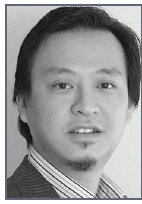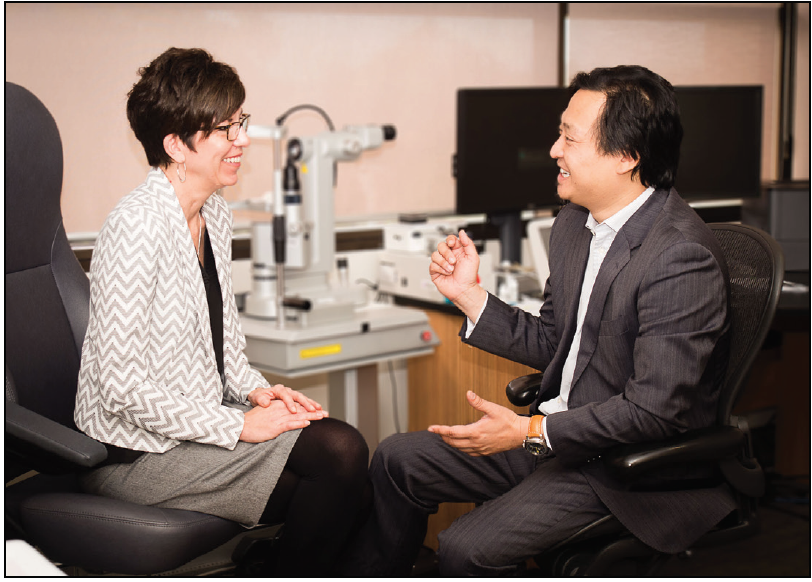
I am a solo practitioner in Perth, Australia. As a corneal subspecialist, one-third of my practice is devoted to corneal surgery, one-third to refractive surgery, and one-third to cataract and related general ophthalmic surgery. I have been performing refractive surgery since 2008 and small incision lenticule extraction, or SMILE, since 2015. In my years of practice, no other procedure has had the same kind of impact as quickly as SMILE has.
THE GROUNDWORK
Our team at Aculase consists of one surgeon (me), two receptionists, one optometrist, one practice manager, and five part-time laser nurses (Figure 1). When we purchased the VisuMax femtosecond laser (ZEISS) 2 years ago, we expected to perform about 100 SMILE procedures in the first year. The volume of SMILE procedures that we have actually performed, however, has well exceeded those expectations. Right now, I use SMILE in 98% of myopic patients who elect refractive surgery. For hyperopic patients, I still perform LASIK.

Figure 1. Dr. Chan and some of the staff at Aculase.
Because of my background in corneal surgery, and because of my experience with lamellar keratoplasty specifically, the technical adoption of SMILE was easy, and it only took me a handful of surgeries to become completely comfortable with the procedure.
Likewise, it did not take patients long to warm up to the idea of SMILE as a solution to their visual needs. Because SMILE provides patients with a flapless option with only a keyhole incision for laser vision correction, we have found that many are drawn to this surgical procedure. Patients are clearly more worried about the corneal flap than I have previously appreciated. I think patients also like the fact that SMILE is performed entirely under the same laser, instead of under two laser platforms like LASIK, and that there is a lower risk of dry eye postoperatively. Many patients who have dry eyes issues with contact lenses are drawn to the lower risk of dry eye with SMILE.
With that said, when we initially introduced SMILE to the patients in our market, we had to keep in mind that we were dealing with an audience that had never heard of the procedure before. Therefore, we focused our marketing efforts on educating patients about the SMILE procedure. The small wound size and the minimal laser treatement time (25 sec) seem to resonate with patients. Now that patients in our market are educated on SMILE and are aware of its benefits, many have come to our practice for refractive surgery simply because we offer SMILE.
Once the procedure is explained to patients clearly (Figure 2), SMILE really sells itself. In the beginning, we had many patients in their 30s come into Aculase inquiring about SMILE; now, however, we are seeing many more younger patients. Additionally, we have seen an increase in the number of health professionals including doctors, nurses, and dentists, who are interested in SMILE because they can particularly appreciate the benefits of keyhole surgery.

Figure 2. Dr. Chan talking with a patient.
As the procedure continues to penetrate and grow the refractive surgery market, I expect that the number of patients coming to our practice specifically asking for SMILE will increase. Right now, we use SMILE to treat myopia and myopic astigmatism between -0.50 and -10.00 D sphere and up to 4.00 D astigmatism; however, in the future that indication might expand and it will probably also be possible to treat patients with a corneal graft, even higher levels of myopia, and, hopefully, hyperopia.
PRICING STRATEGY AND PROFIT MARGINS
At Aculase, we do charge a premium for SMILE, with a price point 15% higher than that of LASIK and 30% higher than that of PRK. Although this has obviously had an impact on our profitability, the main increase in revenue is the higher patient volume. SMILE is also a much quicker procedure than other laser vision correction surgeries; I can perform two SMILE cases in the same time it takes me to perform one LASIK case. In short, more patients are coming through our doors now that we offer SMILE, and we can perform more surgery within the same amount of theater time.
Most patients who come into our practice end up choosing SMILE, despite the premium price. We present all three options to our patients (SMILE, LASIK, and PRK), and our recommendation relates directly to their circumstances. For instance, in a patient who has no preexisiting dry eye and requires a low-power correction, I often tell the patient that he or she will be fine with LASIK or SMILE. Ultimately, they decide on the surgical option based on their preference and budget. Even in the event that a patient does not elect SMILE, he or she still undergoes other surgery at our center, again boosting volume and our profit margin.
We have always treated and will always treat patients equally, whether they decide on SMILE, LASIK, PRK, or any other procedure. However, I find that less chair time is required with SMILE than with procedures like LASIK and PRK, but we maintain similar appointment schedules regardless of procedure.
THE PATIENT EXPERIENCE
As I mentioned, we have been performing SMILE at our practice for 2 years now. One thing that we notice time and again is that patients really have no complaints about the procedure or the recovery process. Patients like that SMILE is quick and painless, that they do not need to wear dressings or goggles on their eyes immediately postoperatively, and that they can resume daily activities relatively right away.
I have heard before that SMILE does not have the same “wow" effect as LASIK; however, in my experience patients have similar visual acuities on day 1 postoperative after SMILE and LASIK. Vision on day 1 postoperative seems to improve with more surgical experience in SMILE. Further, there is no deterioration in vision from dry eye symptoms that some LASIK patients seem to notice 1 week after surgery.
On the other hand, we have a high incidence of dry eye in Australia. A proportion of LASIK patients have deterioration in vision from dry eye symptoms 1 week after surgery; however, SMILE patients do not have this vision-reduction pattern from dry eyes.
SMILE consistently exceeds patient expectations, and therefore they are generally smiling all the way through the procedure and at their follow-up appointments. Because SMILE presents such a strong patient experience, our number of word-of-mouth referrals has also increased. I have treated whole families, several coworkers in the same office, and lunch groups—all from patient referrals.
Further, we have some strong advocates for SMILE in the patients who we have already been treated. I think some of them are bursting at the seams to share how happy they are, and they do this on social media. Also being among the first patients in Perth to have a new procedure is something they are proud of. Having that presence on social media certainly helps our practice.
PROFESSIONAL SATISFACTION
Seeing the joy on our patients’ faces after such a short treatment keeps a smile on my face at postoperative visits. Beyond the clinical benefits of SMILE, there are other rewards in being involved in a successful new procedure. For instance, I had the exciting opportunity to design a dissecting forceps and suggest a new method to perform SMILE to an international audience. Professionally I find it a rewarding experience on many different levels.
I think communication and patient education are still the keys to success with any procedure. We do spend marketing efforts on promoting SMILE specifically, but more importantly patients are learning about SMILE and its benefits through word of mouth and through our educational efforts. Once patients are through the door, we take time to go through the process and discuss the advantages of SMILE as well as the minor side effects they may encounter.
I believe in being realistic with patients instead of over-promising and under-delivering. Also, understanding each patient’s circumstance and tailoring the treatment plan accordingly is important.
I have always been open to trying new procedures, and I always present to patients balanced, educational material about the various procedures that we offer. I do not believe that we have altered the patient workflow or counselling specifically for SMILE patients, but we have seen a natural preference for this minimally invasive laser procedure. Since we began offering SMILE, we have seen an increase in our patient volume.
